Consumers are getting into sports to keep themselves fit. Hence, they are curious to know about sportswear fabric that will bring functionality and sustainability in the long term. Besides, prioritizing comfort and performance is also an important matter that makes a difference. In this article, we bring you sportswear fabric, its making, and types in brief.
Table Of Contents
What is Sportswear Fabric?
Sportswear fabric refers to the sport purpose of serving a single garment. These fabrics are clothing worn for both sports and exercise purposes. Sportswear is also known as sport-tech, activewear.

Features, for instance, lightweight, use of sophisticated technology, and safety differ sportswear from other materials. Because of the technology, these fabrics are technical in nature. These fabrics keep the wearer comfortable during sports.
What is Sportswear Fabric made of?
Sportswear fabric is a cloth made of different ranges of fiber. The only objective is to make the fabric lightweight, durable, breathable, comfortable, and wrinkle-free. Here is the list of the nature of fibers that contribute to the sportswear fabric:
-
Cotton, wool, silk, and other natural fibers.
-
Polyester, Acrylic, Nylon, Spandex, and other synthetic fibers.
-
Microfiber, carbon fiber, lycra, this special synthetic fiber.
-
PCM Fiber, PPS fiber, these high performance fiber.

Sportswear fabric consists of 3 layers. They are:
-
Inner Layer: Close, and flat to the body. This layer absorbs moisture.
-
Mid Layer: In this layer, moisture passes away but not the water. Also, the Gore-tex membrane has an application here.
-
Outer Layer: This layer transports moisture, and provides a protective barrier.
Types of Sportswear Fabric Material
Sportswear fabric comes in a number of types. The only objective is to manage sweat. Besides, sportswear fabric is tough, breathable, moisture-wicking, and mobility protector. Here are the types:
-
Cotton: Cotton does not absorb sweat. But it manages smells or odors effectively. Besides, it does not retain odors during the activity. It is air-permeable.
-
Spandex: Spandex or polyester is exceptional in terms of strength and durability. High-strength fibers are durable and reasonably inexpensive.
-
Synthetic: Synthetic materials are an alternative to rubber-based materials. It supports through the knee and bends of the elbow. Besides, the material is breathable and sweat-absorbing.
-
Bamboo Fiber: Bamboo fiber has anti-static properties. It wicks away moisture and makes the material odorless.
-
Microfiber: This incredibly fine and small thread-based fiber costs expensive.
-
Nylon: This material is stretchable, and mildew-resistant. It dries quickly and provides breathability.

Conclusion
As a terminology, sportswear covers a few areas that go beyond traditional sports. For instance, cycling, rowing, and yoga. Sportswear fabric ensures thermal regulation and offers temperature control. Some of the materials like bamboo, recycled polyester, and organic cotton are sustainable in nature. They will replace synthetic fiber-made sportswear in the year ahead.













Comments - 00
Leave A Reply
Thanks for choosing to leave a comment.